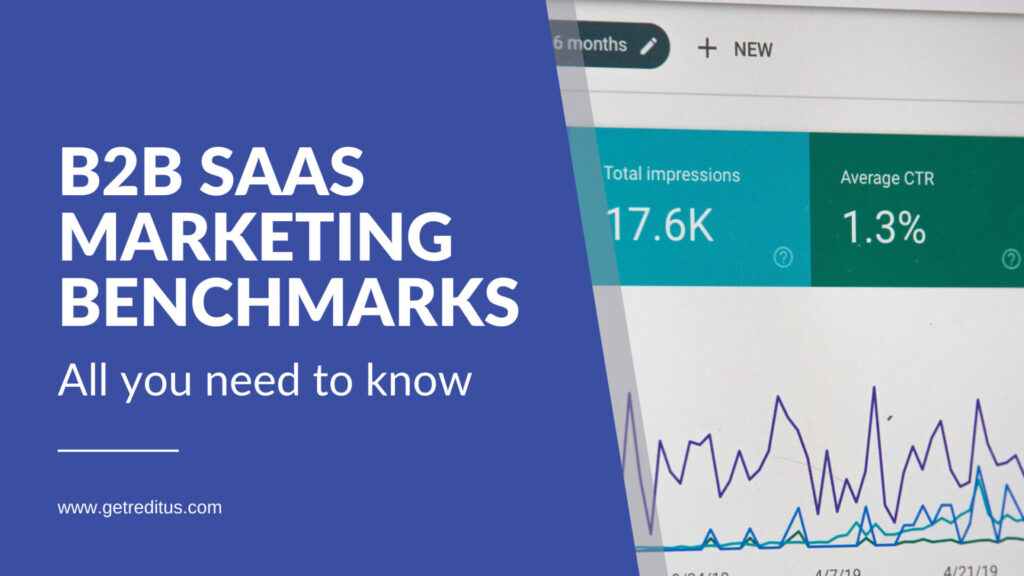All You Need To Know About B2B SaaS Marketing Benchmarks

As the SaaS landscape keeps expanding and having a significant impact across many sectors, it has become increasingly crucial for businesses to understand their performance and evaluate how they stack up against industry standards.
Navigating the world of performance metrics can be complex, given all of the variables at play. One of the most straightforward and effective approaches is to keep an eye on Marketing Benchmarks. Understanding these benchmarks can boost your business and help you stay ahead of the curve, ensuring your business thrives in the competitive SaaS market.
Table of contents
- What is a B2B SaaS Marketing Benchmark?
- What is a B2B Website Benchmark?
- Why Are SaaS Industry Benchmarks Important?
- SaaS Marketing Budget Benchmarks
- B2B SaaS Marketing Benchmarks to Track
- How to Improve Your B2B SaaS Marketing Benchmarks
- B2B SaaS Marketing Benchmarks by Industry
- How Reditus Can Improve Your B2B SaaS Marketing Benchmarks
What is a B2B SaaS Marketing Benchmark?
A B2B SaaS marketing benchmark is a standard or reference point against which businesses can compare their performance. These b2b benchmarks are derived from industry-wide data and provide valuable insights into how well a company performs in various marketing efforts.
Some common B2B SaaS marketing benchmarks include conversion rate, cost per lead, customer acquisition cost, customer lifetime value, monthly recurring revenue, churn rate, win rates, and more.
What is a B2B Website Benchmark?
A website benchmark is a crucial component of evaluating the success of your online presence and plays a significant role in your overall marketing strategy. Unlike regular marketing benchmarks that focus on broader aspects such as customer acquisition cost, conversion rates, and customer lifetime value, website benchmarks specifically analyze your website's performance and its alignment with your business goals. A poorly optimized website can negatively affect your return on investment (ROI), undermining the effectiveness of your marketing efforts.
Here are some key elements to consider when analyzing website benchmarks:
- User Experience (UX)
A seamless and engaging user experience is vital for retaining visitors and converting them into customers. UX includes factors such as site navigation, page load times, mobile responsiveness, and content readability. By monitoring and optimizing these elements, you can ensure that your website effectively supports your marketing strategy and contributes positively to your overall ROI.
- Bounce Rate
Bounce rate refers to the percentage of visitors who leave your website after viewing only one page. A high bounce rate may indicate that your website is not providing relevant or engaging content, or that there are technical issues causing users to leave. Analyzing and improving your website's bounce rate will help you create a more effective online presence and support your overall marketing goals.
- Conversion Rate Optimization (CRO)
CRO is the process of optimizing your website to increase the percentage of visitors who take a desired action, such as signing up for a newsletter, downloading a resource, or making a purchase. By focusing on CRO, you can ensure that your website is effectively contributing to your marketing strategy and maximizing your ROI. This involves analyzing various elements like call-to-action (CTA) placement, form design, and landing page effectiveness.
- Search Engine Optimization (SEO)
SEO is essential for driving organic traffic to your website and improving its visibility on search engine results pages (SERPs). By optimizing your website's content, metadata, and technical aspects, you can increase its search engine ranking and attract more visitors. A well-optimized website supports your overall marketing strategy by generating higher quality leads and improving brand awareness.
- Content Performance
Your website's content should be relevant, engaging, and valuable to your target audience. Monitoring content performance metrics such as page views, time on page, and social shares can help you understand which topics resonate most with your audience and inform your content strategy. By optimizing your content, you can better support your marketing goals and drive higher engagement and conversions.
- Website Analytics
Website analytics tools, such as Google Analytics, provide valuable insights into visitor behavior and site performance. By regularly monitoring and analyzing these data points, you can identify areas for improvement and make data-driven decisions to optimize your website in line with your marketing strategy.
Why Are SaaS Industry Benchmarks Important?
Understanding Performance Metrics
B2B SaaS marketing benchmarks give businesses the foundation they need to understand whether their marketing efforts yield desired results. By comparing their performance to industry standards, companies can identify areas where they excel and those that need improvement. This allows them to make data-driven decisions and optimize their marketing strategies.
Identifying Areas for Improvement with SaaS Company Benchmarks
Identifying areas for improvement involves a systematic approach that includes data analysis, goal setting, and continuous monitoring. Here are some steps to help you identify these areas effectively:
- Gather data: Collect historical data on your company's performance across various marketing metrics, such as conversion rate, cost per lead, customer acquisition cost, customer lifetime value, monthly recurring revenue, churn rate, and lead-to-customer ratio.
- Compare with industry b2b benchmarks: Analyze your company's performance against industry-standard benchmarks to understand how well you perform compared to your competitors. This comparison will highlight areas where your company is underperforming or outperforming the industry average.
- Identify gaps and weaknesses: Based on the comparison, pinpoint specific metrics where your company falls short of the industry benchmarks. These gaps serve as potential areas for improvement.
- Set realistic goals: Establish achievable targets for each metric that needs improvement, considering your company's resources, capabilities, and market conditions. Ensure these goals are SMART (Specific, Measurable, Achievable, Relevant, and Time-bound).
- Develop an action plan: Create a detailed plan outlining the strategies and tactics required to achieve your goals. This plan should address the root causes of underperformance and include initiatives such as optimizing marketing campaigns, enhancing customer retention programs, and improving sales processes.
- Monitor progress: Track your company's performance against the set goals and industry benchmarks. Regular monitoring helps you stay informed about your progress and allows for timely adjustments if necessary.
- Analyze results and iterate: Assess the outcomes of your action plan by comparing the updated metrics against the initial benchmarks. If you've achieved your goals, identify new areas for improvement and continue iterating on your strategies. If not, reevaluate your plan, identify potential roadblocks, and adjust your tactics accordingly.
- Share insights with your team: Communicate your findings and progress with your marketing, sales, and customer success teams. Encourage collaboration and knowledge sharing to ensure that everyone is working towards the same goals and continuously improving.
These steps will help you effectively identify areas for improvement in your SaaS marketing campaign and develop a data-driven strategy to enhance your company's performance. Remember that continuous improvement is key; regularly review your benchmarks and adjust your strategies as needed to stay ahead in the competitive SaaS landscape.
Competitive Analysis
Understanding SaaS industry benchmarks also help businesses gauge their performance relative to competitors. This information can be invaluable when developing marketing strategies and setting goals.
SaaS Marketing Budget Benchmarks
Every department within a company has to deal with budgets. Something you learn pretty quickly when you run a department is how to maximize your budget and make sure you get back the return on investment (ROI) that you need to stay relevant. Doing that involves tracking benchmark metrics.
A SaaS marketing budget benchmark is a comprehensive set of guidelines and key performance indicators (KPIs) that help (SaaS) companies establish, allocate, and manage their marketing budget effectively.
Companies that use these benchmarks will quickly find them to be an invaluable tool for SaaS businesses to compare their marketing spending and strategies against industry standards, allowing them to identify areas of improvement and optimize their overall marketing efforts.
The standards used in a SaaS marketing budget benchmark generally encompass a variety of factors, such as customer acquisition cost (CAC), lifetime value (LTV), churn rate, conversion rates, and overall return on investment (ROI). These metrics provide a holistic view of a company's marketing performance and enable organizations to make data-driven decisions when allocating resources.
The benchmark factors in things like company size, growth stage, target audience, and revenue goals, ensuring that each organization can tailor their marketing budget according to their specific needs and objectives.
B2B SaaS Marketing Benchmarks to Track
Conversion Rate
The conversion rate is the percentage of leads that convert into sales opportunities. With SaaS, this can qualify as a few things, including signing up for paid trial periods, signing long-term contracts, or sometimes even Freemium subscribers. A lot of this depends on your company's business model. The conversion rate is different than the average SaaS win rate, as we’ll show you in a later section.
Conversion rates are a crucial metric for any sales team, not just in SaaS, measuring the effectiveness of marketing efforts. The average SaaS conversion rate varies depending on the industry but generally falls between 3% and 5%, with some industries averaging closer to 12%-15%.
Cost per Lead (CPL)
CPL measures the average cost of acquiring a lead. This metric helps businesses understand the efficiency of their marketing efforts and allocate resources accordingly. B2B SaaS conversion rate benchmarks can provide insights into the expected CPL for various industries.
Average SaaS Win Rate
The Average SaaS Win Rate is a KPI that quantifies the effectiveness of a Software as a Service (SaaS) company's sales process in converting leads into paying customers.
It is calculated by dividing the total number of successful sales or new customer acquisitions by the total number of qualified leads or opportunities during a specific period. The resulting percentage represents the company's win rate, providing valuable insight into the efficiency of their sales strategies and tactics.
A higher average win rate indicates a more effective sales process, while a lower rate may signal the need for improvements or adjustments to better align with customer needs and preferences.
Customer Acquisition Cost (CAC)
CAC is the average cost of acquiring a new customer, including marketing and sales expenses. A lower CAC indicates that a company's marketing efforts are more efficient, while a higher CAC suggests the need for optimization.
Customer Lifetime Value (CLTV)
CLTV is the total revenue generated from a customer throughout their relationship with a business. Understanding CLTV in relation to CAC can help businesses determine if they're investing enough in customer acquisition and retention.
Monthly Recurring Revenue (MRR)
MRR is revenue generated monthly by a company's subscription-based products or services. This is a key performance indicator for SaaS businesses, providing insights into growth trends and the stability of recurring revenue streams.
Churn Rate
The churn rate is the percentage of customers who cancel their subscriptions within a given period. A high churn rate can indicate dissatisfaction with the product or service, while a low churn rate suggests strong customer retention.
How to Improve Your B2B SaaS Marketing Benchmarks
Refine Your Target Audience
You can create more targeted SaaS marketing campaigns and improve conversion rates by narrowing your focus to a specific target audience.
Optimize Your Sales Funnel
Review each stage of your sales funnel to identify areas for improvement. This may include streamlining the lead generation process, refining your sales pitch, or improving customer onboarding.
Improve Customer Retention
Invest in strategies to reduce churn, such as offering better customer support, implementing loyalty programs, and proactively addressing customer concerns.
Experiment with New Marketing Channels
Test different marketing channels to find the most effective ones for your target audience. This may include social media, content marketing, PPC advertising, or influencer partnerships.
Invest in Customer Success
Ensuring customers achieve their desired outcomes with your product or service increases customer satisfaction and reduces churn.
B2B SaaS Marketing Benchmarks by Industry
SaaS Marketing Benchmarks for Tech Companies
Tech companies often have higher conversion rates and lower churn rates compared to other industries, thanks to the innovative nature of their products and services.
SaaS Marketing Benchmarks for Fintech Companies
Fintech companies typically have higher customer acquisition costs due to increased competition and stricter regulations.
SaaS Marketing Benchmarks for Healthcare Companies
Healthcare companies tend to have lower conversion rates and higher churn rates due to the complex nature of the industry and the need for ongoing customer support.
SaaS Marketing Benchmarks for Edtech Companies
Edtech companies often have lower customer lifetime values due to the seasonal nature of the education industry and the limited duration of some educational programs.
How Reditus Can Improve Your B2B SaaS Marketing Benchmarks
Reditus can help your business grow its MRR through affiliate marketing and other growth strategies. By partnering with Reditus, you'll gain access to expert guidance and proven tactics that can help you improve your B2B SaaS marketing benchmarks and outperform your competition.

